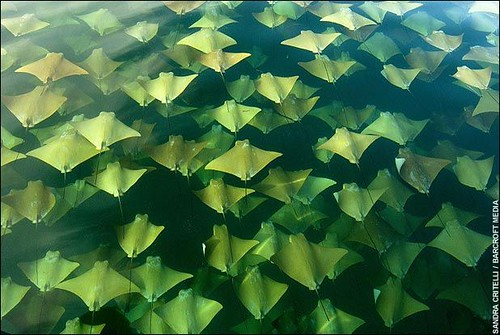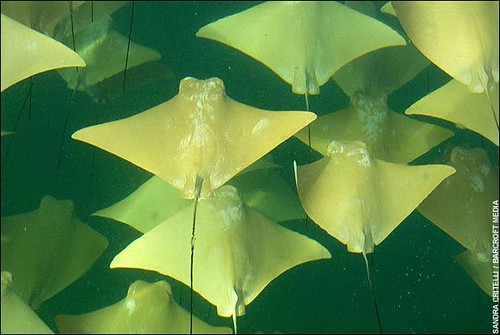tags: Golden Rays, cow nosed rays, Rhinoptera steindachneri, Sandra Critelli, image of the day
Golden (cow nosed) Rays, Rhinoptera steindachneri, gathering off the northern tip of the Yucatan Peninsula, near the coast of Mexico. This spectacular scene was captured as the magnificent creatures made one of their biannual mass migrations to more agreeable waters.
Image: Sandra Critelli [larger view].
Looking like giant leaves floating in the sea, thousands of Golden Ray s are seen here gathering off the coast of Mexico. The spectacular scene was captured as the magnificent creatures made one of their biannual mass migrations to more agreeable waters.
Gliding silently beneath the waves, they turned vast areas of blue water to gold off the northern tip of the Yucatan Peninsula. Sandra Critelli, an amateur photographer, stumbled across the phenomenon while looking for whale sharks.
"It was an unreal image, very difficult to describe," she said. "The surface of the water was covered by warm and different shades of gold and looked like a bed of autumn leaves gently moved by the wind. It's hard to say exactly how many there were, but in the range of a few thousand."
"We were surrounded by them without seeing the edge of the school and we could see many under the water surface too. I feel very fortunate I was there in the right place at the right time to experience nature at its best."
Measuring up to 7ft (2.1 meters) from wing-tip to wing-tip, Golden rays are also more prosaically known as cow nose rays. They have long, pointed pectoral fins that separate into two lobes in front of their high-domed heads and give them a cow-like appearance. Despite having poisonous stingers, they are known to be shy and non-threatening when in large schools.
The population in the Gulf of Mexico migrates, in schools of as many as 10,000, clockwise from western Florida to the Yucatan.



Wow is right. Beautiful photo & ty for the info to go along with it.
Three deep, spread out for miles - that's a lot of critters. Beautiful photos, too.
Golden (cow nosed) Rays, Rhinoptera steindachneri.
Cow nosed? Then howcum the Linnaean name translates as "nose wing"?
Pierce: http://imagecache2.allposters.com/images/pic/APPOD/personaluse_8271381~… Their 'nose' looks a little like a cow's nose, apparently.
This is such an inspiring sight, I hope I could experience something like this someday.
Kendra, that's a fine picture (though the coloration is different - do these guys vary pigmentation by season or suchlike?), and it explains the common name - but not the Latin one...
I wonder how they taste? (seriously). Are they in danger of being overfished?
Wow! What a great picture! That must have been a marvelous sight.
These are stunning photos and Sandra Critelli's description is beautiful.
I would love to have a copy of this soothing, fascinating, unbelievably beautiful scene you have captured. Have you already or have you considered releasing this extraordinary photo as a 2 ft-3ft or larger poster through a specific market - like National Geographic? Imagine the pleasure of gazing on this every morning, just before beginning our own navigation of the day.
Wow, that is amazing! Kudos to Sandra Critelli for some spectacular shots!
According to the Smithsonian Inst. these rays are located in the Pacific, not the Atlantic. Is the Smithsonian wrong? We have never seen them diving before in the Caribbean. Any Marine biologists out there who can shed a little light?
Thanks